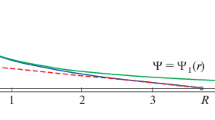Abstract
For the nonlinear Emden–Fowler equation, a singular Cauchy problem and singular two-point boundary value problem on the half-line \(r \in [0, + \infty )\) and on an interval \(r \in [0,R]\) with a Dirichlet boundary condition at the origin and with a Robin boundary condition at the right endpoint of the interval are considered. For special parameter values, the given boundary value problem corresponds to the Thomas–Fermi model of the charge density distribution inside a spherically symmetric cooled heavy atom occupying a confined or infinite space, where \(R\) denotes the boundary of a compressed atom and grows to infinity for a free atom. For the boundary value problem on the half-line, a new parametric representation of the solution is obtained that covers the entire range of argument values, i.e., the half-line \(r \in [0, + \infty )\), with the parameter \(t\) running over the unit interval. For analytic functions involved in this representation, an algorithm for explicit computation of their Taylor coefficients at \(t = 0\) is described. As applied to the Thomas–Fermi problem for a free atom, corresponding Taylor series expansions are given and they are shown to converge exponentially on the unit interval \(t \in [0,1]\) at a rate higher than that for an earlier constructed similar representation. An efficient analytical-numerical method is presented that computes the solution of the Thomas–Fermi problem on the half-line with any prescribed accuracy not only in an neighborhood of \(r = + \infty \), but also at any point of the half-line \(r \in [0, + \infty )\). For the Cauchy problem set up at the origin, a new formula for the critical value of the derivative that corresponds to the solution of the problem on the half-line is derived. It is shown in a numerical experiment that this formula is more efficient than the Majorana formula. For the solution of the Cauchy problem with a positive derivative at the origin, a parametrization is obtained that ensures that the boundary conditions of the singular boundary value problem on the interval \(r \in [0,R]\) are satisfied with a suitable \(R > 0\). An efficient analytical-numerical method for solving this Cauchy problem is constructed and numerically implemented.




Similar content being viewed by others
REFERENCES
E. Fermi, “Un metodo statistico per la determinazione di alcune prioprieta dell’atomo,” Rend. Accad. Naz. Lincei 6, 602–607 (1927).
L. H. Thomas, “The calculations of atomic fields,” Proc. Cambridge Philos. Soc. 23, 542–598 (1927).
A. Sommerfeld, “Integrazione asintotica dell’equazione differenziale di Fermi–Thomas,” Rend. R. Accad. Lincei 15, 293–308 (1932).
R. Bellman, Stability Theory of Differential Equations (McGraw-Hill, New York, 1953).
L. D. Landau and E. M. Lifshitz, Quantum Mechanics: Non-Relativistic Theory (Butterworth-Heinemann, Oxford, 1977; Nauka, Moscow, 1989).
J. H. Lane, “On the theoretical temperature of the sun under the hypothesis of a gaseous mass maintaining its volume by its internal heat and depending on the laws of gases known to terrestrial experiment,” Am. J. Sci. Arts 2, 57–74 (1870).
R. Emden, Gaskugeln: Anwendungen der mechanischen W armetheorie auf kosmologische und meteorologische Probleme (Teubner, Leipzig, 1907).
A. Nachman and A. Callegari, “A nonlinear singular boundary value problem in the theory of pseudoplastic fluids,” SIAM J. Appl. Math. 38 (2), 275–281 (1980).
O. A. Oleinik and V. N. Samokhin, Mathematical Methods in Boundary Layer Theory (Fizmatlit, Moscow, 1997) [in Russian].
B. J. Laurenzi, “An analytic solution to the Thomas–Fermi equation,” J. Math. Phys. 31 (10), 2535–2537 (1990).
A. Wazwaz, “The variational iteration method for solving linear and nonlinear ODEs and scientific models with variable coefficients,” Cent. Eur. J. Eng. 135, 186–205 (2019).
K. Parand and M. Delkhosh, “Accurate solution of the Thomas–Fermi equation using the fractional order of rational Chebyshev functions,” J. Comput. Appl. Math. 317, 624–642 (2017).
X. Zhang and J. P. Boyd, “Revisiting the Thomas–Fermi equation: Accelerating rational Chebyshev series through coordinate transformations,” Appl. Numer. Math. 135, 186–205 (2019).
S. ul I. Ahmad, F. Faisal, M. Shoaib, and M. A. Z. Raja, “A new heuristic computational solver for nonlinear singular Thomas–Fermi system using evolutionary optimized cubic splines,” Eur. Phys. J. Plus 135 (55), 1–29 (2020).
S. V. Pikulin, “The Thomas–Fermi problem and solutions of the Emden–Fowler equation,” Comput. Math. Math. Phys. 59 (8), 1292–1313 (2019).
E. A. Coddington and N. Levinson, Theory of Ordinary Differential Equations (McGraw-Hill, New York, 1955).
S. Esposito, “Majorana solution of the Fermi–Thomas equation,” Am. J. Phys. 70 (8), 852–856 (2002).
S. V. Pikulin, “The behavior of solutions to a special Abel equation of the second kind near a nodal singular point,” Comput. Math. Math. Phys. 58 (12), 1948–1966 (2018).
S. V. Pikulin, “Analytical-numerical method for calculating the Thomas–Fermi potential,” Russ. J. Math. Phys. 26 (4), 544–552 (2019).
S. V. Pikulin, “Traveling-wave solutions of the Kolmogorov–Petrovskii–Piskunov equation,” Comput. Math. Math. Phys. 58 (2), 230–237 (2018).
G. Lampariello, “Su una classe notevole di equazioni differenziali del 2 o ordine non lineari (I, II),” Atti Accad. Lincei 6 (19), 284–290, 386–393 (1934).
H. C. Rosu and S. C. Mancas, “Generalized Thomas–Fermi equations as the Lampariello class of Emden–Fowler equations,” Phys. A: Stat. Mech. Appl. 471, 212–218 (2017).
V. V. Golubev, Lectures on the Analytical Theory of Differential Equations (Gostekhizdat, Moscow, 1950) [in Russian].
Author information
Authors and Affiliations
Corresponding author
Additional information
Translated by I. Ruzanova
Rights and permissions
About this article
Cite this article
Pikulin, S.V. Parametrization of Solutions to the Emden–Fowler Equation and the Thomas–Fermi Model of Compressed Atoms. Comput. Math. and Math. Phys. 60, 1271–1283 (2020). https://doi.org/10.1134/S0965542520080138
Received:
Revised:
Accepted:
Published:
Issue Date:
DOI: https://doi.org/10.1134/S0965542520080138



